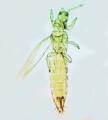Frankliniella gossypiana
Recognition data
Distinguishing features
Both sexes fully winged. Body and legs yellow, distal antennal segments brown; fore wing pale. Head wider than long; three pairs of ocellar setae present, pair III longer than margin of ocellar triangle, arising just within lateral margins; postocular setae pair I present, pair IV as long as distance between hind ocelli. Antennae 8-segmented; III–IV with sensorium forked; segment VIII almost twice as long as VII. Pronotum with 5 pairs of major setae; anteromarginal setae almost as long as anteroangulars; one pair of minor setae present medially between posteromarginal submedian setae. Metanotum with 2 pairs of setae at anterior margin; campaniform sensilla present. Fore wing with 2 complete rows of veinal setae. Abdominal tergites V–VIII with paired ctenidia, anterolateral to spiracle on VIII; posteromarginal comb on VIII with long, regular, microtrichia. Sternites III–VII without discal setae, except sternite II with one or two long discal setae medially.
Male smaller than female; tergite VIII with complete comb; sternite II with one or two discal setae medially, III–VII with small oval pore plate, sternite VII with toothed craspedum on posterior margin.
Related and similar species
F. gossypiana is similar in color and structure to F. williamsi, the common species on Zea mays, but has a more slender head, and the setae on the ninth abdominal tergite are shorter. Keys to 74 species of Frankliniella recorded from Central America and the Carribean were provided by Mound & Marullo (1996), and to 40 species from Brazil by Cavalleri & Mound (2012).
Taxonomic data
Current valid name
Frankliniella gossypiana Hood
Original name and synonyms
- Euthrips gossypii Morgan, 1913: 9
- Frankliniella gossypiana Hood, 1936: 68
[Hood provided F. gossypiana as a replacement name for that used by Morgan, because of the prior existence in Japan of the name E. gossypii Shiraki]
Family placement
Thripidae, Thripinae
Biological data
Life history
Presumably breeding in flowers; adults are recorded sheltering under the webbing of spider mites on leaves (Mound & Marullo, 1996).
Host plants
Various flowers, including Ipomoea species (Convolvulaceae)
Tospoviruses vectored
None
Crop damage
None recorded
Distribution data
Area of origin
Possibly Mexico
Distribution
California, Arizona, Texas, New Mexico, Utah, Mexico, Costa Rica.





